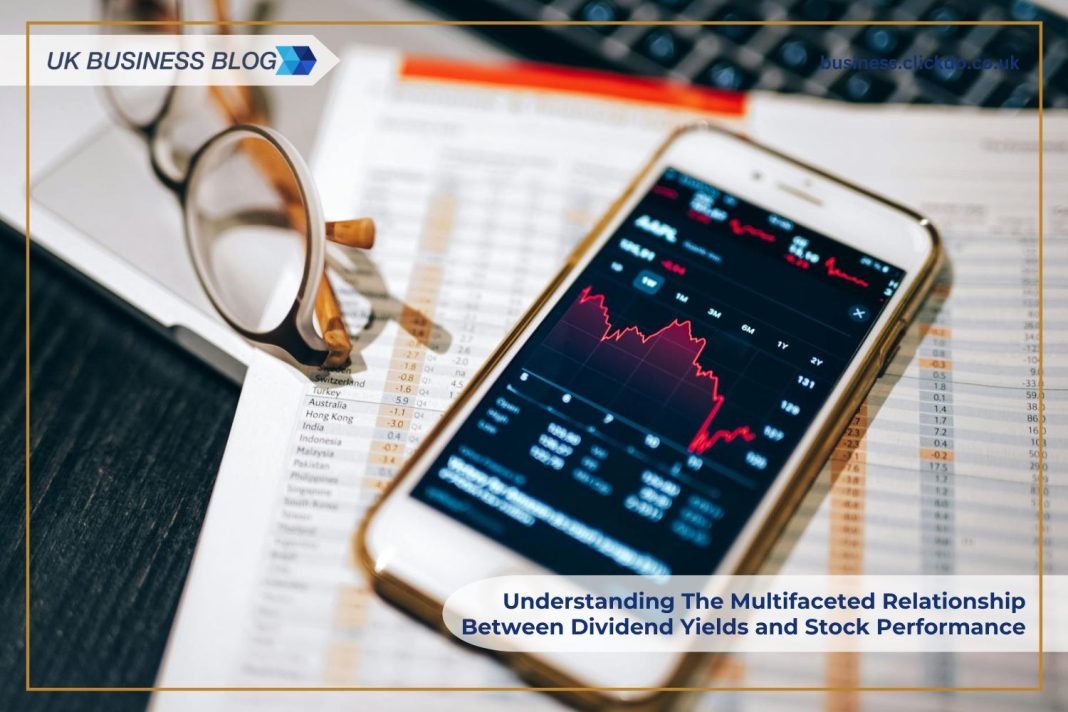Table of Contents
Understanding the relationship between dividend yields and stock performance is crucial for investors seeking to optimize their portfolios. Dividend yields, the annual dividend payment divided by the stock price, offer insights into a company’s financial health and its approach to returning value to shareholders.
Conversely, stock performance, reflecting price appreciation and total return, is influenced by various factors including market conditions and company fundamentals. Visit https://immediate-mentax.org/ to have a clear understanding of the market and invest with confidence.
What Are Dividend Yields?

Dividend yields represent the income generated from an investment in the form of dividends. Calculated as the annual dividend divided by the stock price, this metric indicates how much a company pays out relative to its share price. For instance, a company paying $2 in annual dividends with a share price of $50 has a dividend yield of 4%.
Companies determine dividends based on profitability and strategic goals. Dividends can be cash payments or additional shares. Cash dividends are straightforward, while stock dividends increase the number of shares held by investors, potentially diluting share value but rewarding loyal investors.
Understanding Stock Performance
Stock performance is measured through price appreciation and total return, which includes both capital gains and dividends. Key metrics for evaluating performance include earnings per share (EPS), price-to-earnings (P/E) ratio, and total return. Market trends, economic indicators, and company-specific factors such as earnings growth or management decisions also impact stock performance.
Theoretical Relationship Between Dividend Yields and Stock Performance
Theoretical models like the Dividend Discount Model (DDM) suggest that dividend yields play a significant role in stock valuation. According to the DDM, the value of a stock is the present value of its expected future dividends. Higher dividend yields may indicate a lower stock price, assuming dividends remain constant, reflecting either a market undervaluation or company-specific issues.
Dividend signaling theory posits that companies paying high dividends signal financial health and stability. Investors may interpret stable or increasing dividends as signs of strong earnings, potentially boosting stock prices. However, high yields can also result from falling stock prices, indicating potential issues.
Empirical Evidence: Case Studies and Research

Empirical studies provide mixed evidence on the relationship between dividend yields and stock performance. Research shows that high dividend yields often correlate with lower stock price volatility and more stable returns. For example, companies like Procter & Gamble and Johnson & Johnson, known for their consistent dividend payments, have demonstrated resilient stock performance over time.
Conversely, studies indicate that high dividend yields can sometimes mask underlying problems, leading to lower stock performance. For instance, companies in financial distress may increase dividend yields to attract investors, despite deteriorating fundamentals.
The Role of Market Conditions
Market conditions significantly impact the relationship between dividend yields and stock performance. During bull markets, investors may prioritize growth stocks over dividend payers, leading to lower relative yields. Conversely, in bear markets or economic downturns, dividend-paying stocks often become more attractive as they offer a steady income stream, potentially stabilizing performance.
Economic conditions like inflation also play a role. High inflation can erode the purchasing power of dividend payments, affecting investor perceptions and stock performance. In contrast, during deflationary periods, dividend yields may appear more attractive relative to low interest rates.
Dividend Yields and Stock Volatility
The relationship between dividend yields and stock volatility is complex. Generally, high dividend yields are associated with lower stock volatility, as steady dividend payments can buffer against price swings. However, stocks with unusually high yields might experience higher volatility due to concerns about sustainability. For instance, if a company’s high yield results from a plummeting stock price, it could signal underlying instability, leading to increased volatility.
The Impact of Dividend Policy Changes

Changes in a company’s dividend policy can significantly affect its stock performance. Increasing dividends often signal confidence in future earnings, potentially boosting stock prices. Conversely, dividend cuts may indicate financial distress, leading to negative stock reactions. For example, during the COVID-19 pandemic, many companies reduced or suspended dividends, causing declines in stock prices and investor confidence.
Comparative Analysis: Dividend Stocks vs. Growth Stocks
Dividend-paying stocks and growth stocks represent different investment strategies. Dividend stocks appeal to income-focused investors seeking regular returns and lower volatility. They often come from established companies with stable earnings. In contrast, growth stocks reinvest earnings into expansion rather than paying dividends, offering the potential for higher capital appreciation but with higher volatility.
Investors should align their choices with their financial goals and risk tolerance. Dividend stocks provide stability and income, suitable for conservative investors, while growth stocks offer potential for substantial capital gains, suited for those willing to accept higher risk.
Investor Strategies: Leveraging Dividend Yields for Optimal Returns
To leverage dividend yields effectively, investors should consider several strategies. Incorporating dividend stocks into a diversified portfolio can provide steady income and stability. Reinvesting dividends through a Dividend Reinvestment Plan (DRIP) can compound returns over time.
Investors should also evaluate the sustainability of dividend yields, focusing on companies with a history of reliable payments and strong financial health. Balancing dividend income with growth opportunities can enhance portfolio performance while managing risk.
Conclusion
The relationship between dividend yields and stock performance is multifaceted, influenced by theoretical models, empirical evidence, and market conditions. Understanding this relationship helps investors make informed decisions, balancing income and growth potential. By analyzing dividend yields in conjunction with stock performance metrics and market conditions, investors can optimize their portfolios and align their investments with their financial objectives.
Author Profile
- Blogger and Educator by Passion | Senior Online Media & PR Strategist at ClickDo Ltd. | Contributor to many Education, Business & Lifestyle Blogs in the United Kingdom & Germany | Summer Course Student at the London School of Journalism and Course Instructor at the SeekaHost University.
Latest entries
 BusinessDecember 2, 2025How to Build an Effective Progression Plan in Your Company
BusinessDecember 2, 2025How to Build an Effective Progression Plan in Your Company BusinessOctober 24, 2025Legionella Risk Assessment: 5 Things Every Entrepreneur Needs to Know
BusinessOctober 24, 2025Legionella Risk Assessment: 5 Things Every Entrepreneur Needs to Know EmploymentSeptember 2, 2025Why Motorbike Accident Staff Claims are a Growing Business Risk
EmploymentSeptember 2, 2025Why Motorbike Accident Staff Claims are a Growing Business Risk FinanceAugust 21, 2025A Swiss Bank Account for Foreigners: Stability, Tradition, and Options for International Clients
FinanceAugust 21, 2025A Swiss Bank Account for Foreigners: Stability, Tradition, and Options for International Clients





